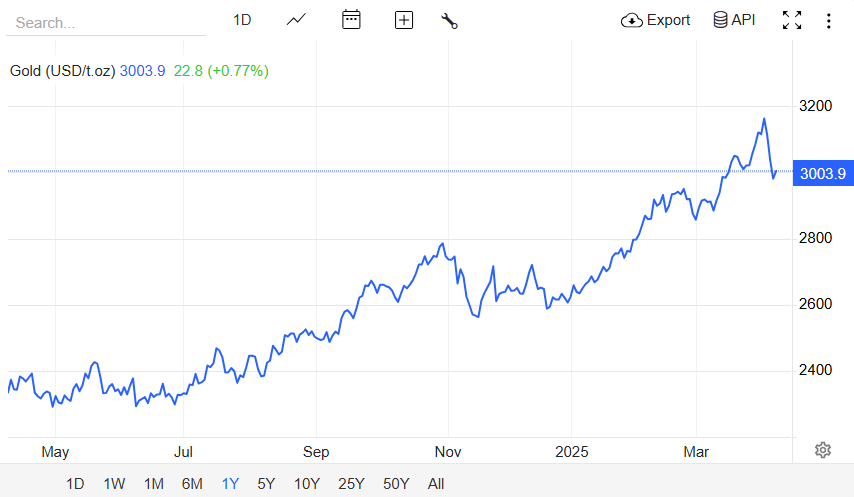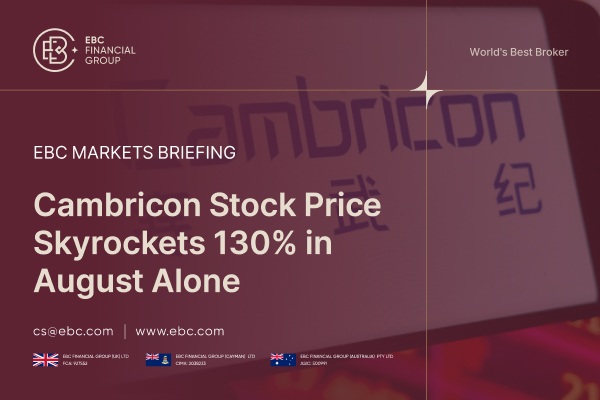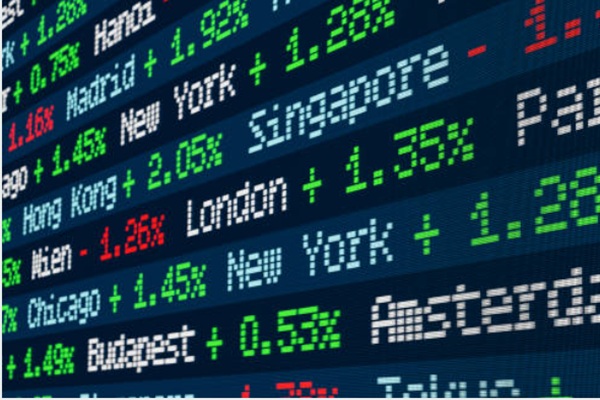In April 2025, gold prices experienced significant volatility, reaching record highs before undergoing corrections. This fluctuation has been influenced by various economic and geopolitical factors, prompting investors to reassess their positions in the gold market.
This analysis delves into the factors affecting gold prices, examines technical indicators, and provides a gold price forecast for April 2025 and the remainder of 2025.
Current Gold Price Trends

In the first week of April 2025, gold prices reached unprecedented levels. On April 2, gold futures for April delivery closed at a record $3,139.90 per troy ounce, marking a 19% year increase. This surge is attributed to investor concerns over the economic implications of newly announced tariffs and sustained central bank demand for gold.
However, this upward trajectory experienced a slight correction. On April 4, gold prices settled at $3,113.89, reflecting a 1.54% decline from the previous close. This dip was influenced by a broad market sell-off following the announcement of sweeping 10% tariffs on all imports by the U.S. administration. This led investors to liquidate assets to raise cash amid increasing uncertainty.
This downward trend continued, with spot gold prices falling to $3,012 on April 7, reflecting a 3.17% decline from the opening price of $3,110.15.
Factors Influencing Gold Price Forecast April 2025
Several key elements have contributed to the recent movements in gold prices:
1) Trade Tensions and Tariffs: In early April 2025, President Donald Trump announced significant tariffs on imports, including a 25% tariff on imported vehicles. China responded with retaliatory measures, imposing additional levies of up to 34% on U.S. goods. These actions have heightened fears of a global recession, prompting investors to seek safe-haven assets like gold.
2) Central Bank Purchases: Central banks have continued to increase their gold reserves. Notably, China's central bank expanded its gold holdings for the fifth consecutive month, signalling sustained demand for the precious metal.
3) Market Volatility and Investor Behavior: The imposition of tariffs led to a significant sell-off in U.S. stocks, with some calling it the steepest in three decades. Investors, concerned about the U.S.'s increasingly isolationist stance, fled traditional safe havens like the dollar for assets such as gold, the yen, and the Swiss franc.
Technical Analysis and Support Levels
Technical indicators provide insights into potential future movements of gold prices:
Support and Resistance Levels: Gold recently reversed up from the support area around the $3,000 mark, which had previously halted minor corrections. This area was reinforced by the lower daily Bollinger Band and the support trendline of the daily up channel from January.
Moving Averages and RSI: The 14-day Relative Strength Index (RSI) remains above 50, indicating that the bullish bias for gold will likely remain intact. However, maintaining levels above $3,000 is crucial for this trend.
Analyst Predictions and Investment Considerations
Analyst opinions on the future trajectory of gold prices vary:
Deutsche Bank has raised its average gold price forecasts for 2025 and 2026 to $3,139 and $3,700 per ounce, respectively.
Bank of America projects that gold could reach $3,400 per ounce, citing factors such as central bank purchases and retail interest.
Goldman Sachs forecasts a price of $3,300 by year-end, while Macquarie Group anticipates gold reaching $3,500 per ounce.
Conversely, some analysts predict potential declines. For instance, Jon Mills of Morningstar forecasts a drop to $1,820 per ounce, attributing this to increased gold supply and decreased demand from investors and central banks.
Given the current market dynamics, investors should consider the following:
Diversification: Incorporating gold into a diversified portfolio can provide a hedge against market volatility and economic uncertainty.
Market Timing: Monitoring technical indicators and support levels can aid in identifying optimal entry and exit points for gold investments.
Risk Assessment: Understanding the factors influencing gold prices, including geopolitical events and central bank policies, is crucial for making informed investment decisions.
Outlook for the Remainder of 2025

Analysts have provided varying forecasts for gold prices through the end of 2025:
Goldman Sachs: The firm has increased its year-end gold price projection to $3,300 per ounce, citing continued central bank demand as a primary driver.
J.P. Morgan Research: Forecasts indicate that gold prices could rise toward $3,000 per ounce in 2025, with a fourth-quarter average of $2,950 per ounce.
InvestingHaven: Their analysis suggests that gold prices might approach $3,275 in 2025 and $3,805 in 2026, eventually reaching $5,155 by 2030.
These projections underscore a generally bullish sentiment for gold, driven by factors such as central bank purchases, geopolitical tensions, and economic uncertainties.
Conclusion
The gold market in April 2025 reflects a confluence of trade tensions, central bank activities, and market volatility. While technical indicators suggest potential consolidation, the overall outlook for gold remains positive, with analysts forecasting continued price appreciation through the end of 2025.
However, investors should remain vigilant by considering both technical signals and broader economic developments when making gold investments.
Disclaimer: This material is for general information purposes only and is not intended as (and should not be considered to be) financial, investment or other advice on which reliance should be placed. No opinion given in the material constitutes a recommendation by EBC or the author that any particular investment, security, transaction or investment strategy is suitable for any specific person.








